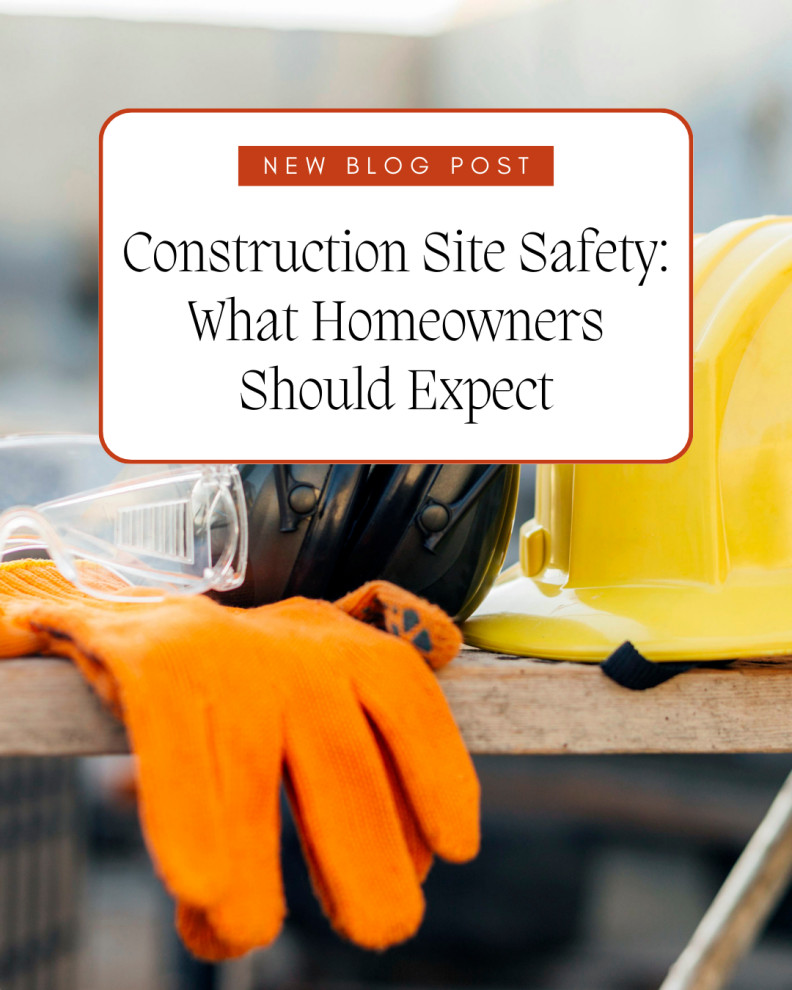Construction Site Safety: What Homeowners Should Expect

When you decide to remodel your home, add an ADU, or start any major construction project, excitement usually runs high. You imagine the finished product—new spaces, upgraded finishes, and a home that better suits your needs. But between design and completion lies an active construction site. For homeowners, it’s important to know what to expect when it comes to safety.
A construction site isn’t just a place where progress happens—it’s also a place with potential hazards. Understanding how contractors manage safety helps you feel confident in the process and gives you peace of mind while work is underway.
Below, we’ll walk through the key things homeowners should expect regarding construction site safety.
1. Clear Safety Boundaries
The first thing you’ll notice on a construction site is boundaries. Contractors will often section off areas with temporary fencing, caution tape, or barriers. This serves two purposes:
- Protecting homeowners and visitors from entering dangerous areas.
- Creating a safe workspace for workers, free from interruptions.
If you’re living in the home during construction, your contractor will set clear paths for you to use so you can safely move in and out without walking through active work areas. Expect doors to be blocked off, rooms to be sealed with plastic, or even temporary walls in place.
2. Protective Gear and Worker Safety
Construction workers are trained to follow safety protocols. You’ll see them wearing:
- Hard hats to prevent head injuries.
- Safety glasses for protection from dust or flying debris.
- Gloves and boots for handling tools and materials.
This may look excessive at times, but it’s all part of OSHA (Occupational Safety and Health Administration) standards. As a homeowner, you won’t need this gear if you’re only observing from a safe distance, but don’t be surprised if your contractor asks you to wear a hard hat when entering certain areas.
3. Dust, Noise, and Containment
Construction is messy—there’s no way around it. Sawing, sanding, and demolition produce dust. Hammers, drills, and machinery create noise. Your contractor should take steps to minimize these impacts, such as:
- Installing plastic barriers to contain dust.
- Using HEPA filters or air scrubbers if work involves fine particles.
- Scheduling the loudest tasks during reasonable hours.
As a homeowner, you should expect some disruption, but you should also expect your contractor to communicate what to anticipate each week.
4. Proper Handling of Tools and Materials
Safety doesn’t just mean wearing the right gear—it also means handling equipment properly. Tools, ladders, scaffolding, and heavy machinery are always potential hazards if left unattended.
A good contractor will make sure:
- Tools are stored properly at the end of each workday.
- Ladders and scaffolds are stable and secured.
- Materials like lumber, nails, or pipes are stacked neatly and not blocking walkways.
For you, this means you shouldn’t find random nails in the driveway or piles of lumber leaning where they could fall.
5. Hazardous Materials and Waste Removal
Depending on your project, hazardous materials may be present. Examples include:
- Lead paint (in older homes).
- Asbestos (in certain insulation, flooring, or roofing).
- Solvents, adhesives, and chemicals used in the building process.
Licensed contractors know how to handle and dispose of these materials safely. You should expect them to follow environmental regulations and keep you informed if something hazardous is discovered.
Waste management is another big part of safety. Dumpsters or designated bins should be on-site to collect debris, and your property should not be left littered with scraps.
6. Emergency Preparedness
Accidents are rare but can happen. Professional contractors are prepared with:
- First aid kits on-site.
- Fire extinguishers for emergencies.
- Clear exit paths in case of evacuation.
It’s also standard practice for contractors to brief workers on emergency procedures. While you as the homeowner don’t need to memorize these, it’s good to ask your contractor what their safety plan looks like.
7. Communication and Respect for Your Home
Finally, one of the most overlooked aspects of construction safety is communication. Your contractor should:
- Let you know which areas are off-limits each day.
- Provide updates on safety-sensitive tasks, such as electrical or structural work.
- Respect your property by keeping dangerous tools and materials contained.
When you’re informed, you can better plan your routine around the work and avoid unnecessary risks.
Final Thoughts
Construction site safety isn’t just about protecting workers—it’s also about protecting you, your family, and your home. As a homeowner, you should expect clear boundaries, clean and organized workspaces, proper waste management, and open communication from your contractor.
At Coleman Build, safety is one of our top priorities. We believe a safe job site creates a smoother project, happier homeowners, and better results. When you choose to work with us, you can trust that safety is built into every step of the process.
Ready to Start Your Project Safely?
Whether you’re planning a kitchen remodel, a bathroom upgrade, or building an ADU, Coleman Build is here to bring your vision to life—with safety and quality as our foundation.
👉 Contact us today to schedule a consultation and see how we can make your project safe, smooth, and successful.
